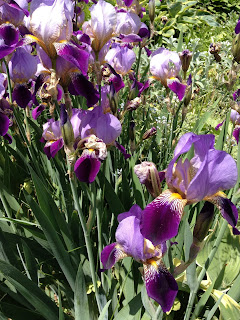 |
| Iris |
Iris
Cancer, Virgo
Connection to source energy, Healing with color
Iris are perennials that grow from 6 inches to up to 40 inches. Flowers grow on stalks and are in many colors, including blue, purple, yellow, white, pink, red, orange and brown. Most Iris varieties have flat leaves that fan out around the stalks.
Iris roots are rhizomes, which grow at the soil surface, and produce horizontal roots and new flowering stalks for the plant. The iris plant can easily be propagated by dividing the rhizomes. Some Iris varieties are grown from bulbs. More than 60,000 cultivars (types of iris) are grown. A common name for some types of iris is "flags."
In Japan, Iris is known for its purifying energies and the flower is worn to protect the wearer.
Iris, in Greek mythology, is a goddess of the rainbow and is a messenger of the gods. She was also known as a goddess of the sea and sky. Iris has unique capabilities related to her goddess status. The plants receive source energy/divine energy as all living things do but what makes Iris unique is that the purpose of the plants are to to be open to receive source energy or the energy of the heavens. Iris is one of the light workers of the plant family and you can become familiar with Iris to work in partnership with the plant to leverage this unique capability. You can sit near Iris plants and absorb the energy they are receiving. For those who practice shamanic journey, the stem or leaves of the Iris plant can be used as an energy conduit or focal point to jump into the lower world. Iris can also be used in combination with the wind as a jumping off point to the middle world.
If you are specifically drawn to Iris you can contemplate whether you could benefit from the energy Iris receives from the heavens or whether you need to be more open to receiving source energy. You can work with the energy Iris brings in your own light worker practice, and to receive high vibration energy that you and others can use with the intent to heal. As Iris is goddess of the rainbow, Iris will assist with healing with color.
Iris is poisonous if ingested. The plants are deer and rabbit resistant.
Iris is available in many varieties:
- African Iris (Dietes bicolor) - likes full sun and is drought tolerant. Produces white flowers accented with yellow and blue.
- Bearded Iris (Iris germanica) - also known as German Iris. Many types are available with plants growing from 8 to 38 inches high. Flowers bloom in a variety of colors, depending on variety, from mid-spring to early summer and require good drainage.
- Dutch Iris (Iris hollandica) - grows from bulbs and blooms in spring. Likes full sun and well drained soil. Popular with florists due to long stems and long lasting flowers.
- Dwarf Crested Iris (Iris cristata) - grows in part to full shade and blooms in white, purple and blue from March to May. Clusters of leaves grow from 4 to 16 inches high with flowers 2.5 inches wide.
- Japanese Iris (Iris ensata) - will grow in shallow standing water and poorly drained soil. Also known as the Butterfly Iris.
- Louisiana Iris (Iris brevicaulis, Iris fulva, Iris giganticaerulea, Iris hexagona, Iris nelsonii) - five species native to Louisiana and the Gulf Coast. These plants tolerate swamp conditions, like full sun and are dormant in August and September.
- Siberian Iris (Iris sibirica) - blooms in late spring and early summer and will grow in poorly drained soil. Plants produce clumps of grassy leaves, and are native to Northern Italy, Turkey and Southeast Russia.
- Walking Iris (Neomarica gracilis) - attracts bees, butterflies and birds. Grows from 10 to 36 inches high and usually has 12 leaves.


